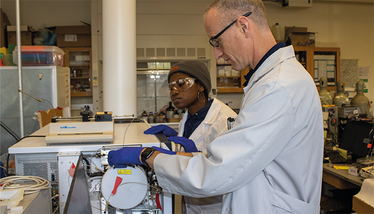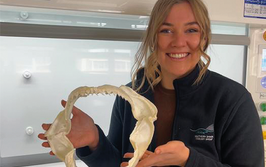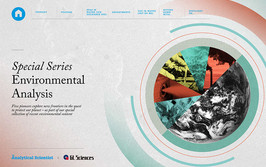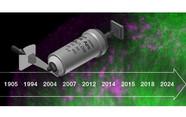This week’s Mass Spec News
Atmospheric alarms, Snowball Earth, and TOF MS advances – your weekly roundup of mass spec news!
Henry Thomas | | 3 min read | News

WVU doctoral student Alexandra Adeoye and forensic chemist Glen Jackson load a sample for analysis on a Q-TOF mass spectrometer, which measures the accurate mass of different drugs and their fragments. Credit: WVU Photo/Maddy Watson
Worth Your Time
US National Institute for Justice grants nearly $400,000 to West Virginia University to adapt current psychoactive substance (e.g. fentanyl) analysis techniques for tandem mass spectrometry – to be used in crime scene investigations. Link
A review of the changes and advancements in the development of multi-pass analyzers for time-of-flight mass spectrometry (TOF MS) over the past two decades, signaling faster detection rates and tighter beam compression as areas for improvements in multi-reflecting (MRT) technology. Link
Researchers use real-time library searches for glycoproteomic data acquisition for tandem mass spectrometry (MS/MS), observing site-specific characterization of both N- and O-glycopeptides relative to traditional methods for each. Link
An optimized workflow for multiplex DIA mass spectrometry combined with dynamic SILAC labeling (pSILAC) to measure protein turnover is introduced alongside KdeggeR: a new data processing package designed to visualize peptide and protein degradation rates. Link
A study from the Center for Genomic Regulation reveals how metabolic enzymes are able to inherit secondary functions within the nucleus; the researchers use mass spectrometry to characterize the MTHFD2’s nuclear interactome’s role regarding cell growth, as well as proper cell mitosis. Link
Comparisons of the proteomic and functional differences between human embryonic (hESCs) and induced pluripotent stem cells (hiPSCs) using LC-MS reveal potential risks and benefits for the latter’s use in future disease modeling and therapeutics. Link
The Analytical Scientist Presents:
Enjoying yourself? There's plenty more where that came from! Our weekly Mass Spec Newsletter brings you the most popular stories as they unfold, chosen by our fantastic Editorial team!
Essential Reading
Chewing the Fat
A Turn for the Better
A few weeks ago, we touched on a newly developed way to analyze protein complex dynamics, known as serial ultrafiltration combined with limited proteolysis coupled to mass spectrometry (FLiP-MS).
Our full interview with co-authors Cathy Marulli, Paola Picotti and Natalie de Souza on their findings is now live! Looking forward, they hope the method will be used to accumulate a library of protein-binding interfaces (PBIs), to better understand the effects mutations have in cancer and disease mechanisms.
“There is more and more literature showing that PPI networks largely rewire in human diseases, suggesting that targeting those interactions could be a therapeutic strategy. Our current study is in yeast, but can easily be implemented in a human system. Once we’ve done that, FLiP-MS has the throughput and scalability to, in principle, track changing PPIs across the human proteome in patient samples to pinpoint interactions dysregulated in a disease, possibly even in a personalized manner.”
Greatest Snow on Earth
A recent study has provided the best evidence yet in favor of the “Snowball Earth” theory – a concept proposing that the Earth was once covered in a thick layer of ice hundreds of millions of years ago.
Analyzing samples of sandstone ridges formed in Colorado’s Rocky Mountains using high-resolution laser ablation-inductively coupled plasma mass spectrometry (LA-ICP-MS), researchers were able to date (what they believe to be) remnants of subglacial meltwater events from the Sturtian glaciation.
"We want to get the word out so that others try and find these features and help us build a more complete picture of Snowball Earth," said co-author Liam Courtney-Davies in a press release. “We have to better characterize this entire time period to understand how we and the planet evolved together.”
Read the full story here!
Deputy Editor of The Analytical Scientist

















